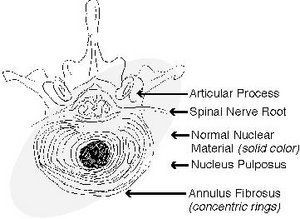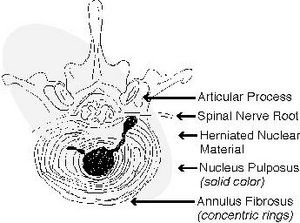Whether you accept it, avoid it or live somewhere in between, insurance coverage has become a defining issue for our profession. Patients increasingly expect to use their benefits, practitioners want to be compensated fairly for their time and expertise, and the system itself remains – at best – fragmented. The encouraging news is that coverage has expanded in meaningful ways. The challenging news is that reimbursement, across the board, remains inadequate.
Help for Prolapsed Intervertebral Discs of the Lumbar Region (Herniated Discs)
Prolapse of intervertebral discs of the lumbar region, or lumbar herniation, is a frequent problem for which patients seek treatment. In Oriental medicine, it has three etiologies:
- Injury to the area;
- Invasion of wind, cold, or damp to an overtaxed condition;
- Liver and kidney deficiency resulting in lack of nourishment to the channels.

Symptoms include radiative pain of the lower limbs; sensory disturbances to the same area; difficulty lifting the leg; and unilateral or bilateral sciatica. The pain may be severe or worse with lumbar flexion of the low back, and may be aggravated by a prolonged sitting or standing position in the dermatome area of the affected nerve root.
Normally, the intervertebral disc lies between the vertebral bodies of the spine and forms a mobile joint called a symphysis, which consists of the nucleus pulposus and annulus fibrosus. The nucleus is a ball of transparent jelly, collagenous fibers, cells and mucopolysaccharides. The annulus fibrosus is made up of rings of fibers oriented in different directions that surround the nucleus with a tough casting.
The discs serve as shock absorbers of the forces of compression. The ability of the nucleus to become distorted, and of the annulus fibrosus to bend, gives the vertebral bodies the ability to move on each other and to distribute the forces of compression. As we age, the nucleus tends to shrink and become dry, and therefore to become less elastic and more fibrous. The annulus fibrosus concomitantly thickens and becomes more prone to rupture.

Technically speaking, a prolapsed disc refers to the herniation of the nuclear material due to tears in the annulus fibrosus. Pain and inflammation develop from pressure of the nucleated material on the posterior longitudinal ligament and the dura mater. The nerve root that can be affected is the one below the vertebra. The vertebral levels most subject to herniation are L4, L5 and S1. If the nerve root becomes affected, pain may be experienced in the corresponding dermatomal area, and weakness and reduced reflexes may develop in the muscles. For an appreciation of this problem, Figures 1 and 2 depict a normal and herniated disc, respectively.
The treatment plan for such a condition involves the breakdown and absorption of the herniated nuclear material and repair to the torn fibers of the annulus fibrosus and posterior longitudinal ligament. In Oriental medicine, an effective treatment strategy for prolapsed intervertebral discs is a prescription called eight needle technique. Eight needle technique is a Chinese treatment plan typically differentiated as clinically effective for kidney qi and yang deficiency resulting in low back pain. It consists of eight points essentially in the local area of herniation, or points with energetics primarily centered around remediating kidney qi and yang xu.
These points are BL23 (shensu) [bilateral], GV4 (mingmen), BL25 (dachangshu) [bilateral], GV3 (yaoyanguan) and BL40 (weizhong) [bilateral]. All of the points are located in the standard Chinese locations and needled to the standard Chinese depths of insertion. For clinical convenience, the points, angles, depths of insertion and energetics are summarized in Table 1.
| Table 1: The Eight Needle Points. | ||
| Points | Angles and Depths of Insertion | Energetics |
| BL23 | Perpendicularly .8-1 in Moxa applicable |
Back shu point of the kidney; regulates the qi of the kidney (both kidney yin and yang). Resolves dampness in the lower burner. Strengthens the back. Nourishes kidney essence, benefits the bones and marrow. Nourishes blood. |
| GV4 | Perpendicularly .5-1 in Moxa applicable |
Tonifies the original kidney qi; that is, the person's condition, vitality and genetic inheritance on a physical and mental level. Strengthens kidney yang. Strengthens the lower back; expels cold; dries damp-cold. |
| BL25 | Perpendicularly .8-1.5 in Moxa applicable |
Back shu point of the large intestine; eliminates stagnant qi and blood that may cause pain; numbness; muscular atrophy; and motor impairment of the back and lower extremities. Removes obstruction from the channel. Benefits the low back; strain; pain in the sacroiliac joint; and relieves fullness; swelling; and paralysis of the lower extremities. |
| GV3 | Perpendicularly .5-1 in Moxa applicable |
Tonifies kidney yang and qi. Strengthens the lower back and legs. Especially for backache that radiates to the legs; pain in the lumbosacral region; numbness; muscular atrophy; motor impairment; weakness of the legs; and knee pain caused by kidney qi and yang xu. Warms cold and dries damp. |
| BL40 | Perpendicularly 05-1.5 in Moxa applicable |
He-sea point of the bladder channel. As the earth point, it is the controlling point of the channel. Clears dampness from the bladder channel. Eliminates blood stasis and channel obstruction that creates lower leg pain. Relaxes the sinews and tendons; opens the channel to benefit the lower back, knees, hips and legs. For chronic or acute, excess or deficiency-type backaches, but most effective for acute, excess backache that is neither unilateral or bilateral, but not on the midline. |
Position the patient as comfortably as possible on a treatment table by having them lie on their stomach. If this prone position makes the patient's back uncomfortable, put a thick, firm pillow under the patient's abdomen. This will take the pressure off the low back and open up the patient's spine to assist in needle insertion.
While Bladder 23 and 25 may be needled in a perpendicular fashion, clinical experience has shown that an oblique insertion toward the spine is clinically effective to change the position of the prolapse and the neural roots, thereby reinforcing the therapeutic effect. All of the back joints additionally have the function of easing pain; decreasing inflammation; activating blood flow; dredging the meridians; and stimulating the nerve root directly. In this way, the surrounding edema may be absorbed and the protrusion of the lumbar intervertebral disc rectified. The needle technique applied to each point depends upon whether the point needs to be tonified or dispersed. As in all cases of tonification and dispersion, needle retention times will vary, but as a general rule, retain the needles 20 minutes.
If the patient's back pain is correctly differentiated due to prolapsed intervertebral discs of the lower extremities and eight needle technique is applied, results are frequently efficacious and long-lasting, with the added benefits accrued from tonifying kidney qi and yang xu, the root qi of the body.1
Reference
- Gardner-Abbate S. Holding the Tiger's Tail: An Acupuncture Technique Manual in the Treatment of Disease. Santa Fe, NM: Southwest Acupuncture College Press, pp. 81-86.



